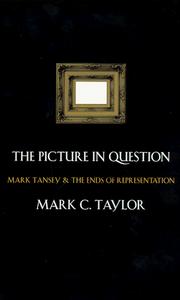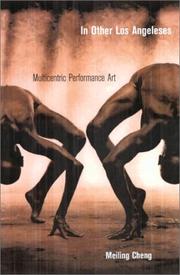| Listing 1 - 3 of 3 |
Sort by
|
Book
Year: 2020 Publisher: Antwerp
Abstract | Keywords | Export | Availability | Bookmark
 Loading...
Loading...Choose an application
- Reference Manager
- EndNote
- RefWorks (Direct export to RefWorks)
Cognitive psychology --- Human medicine --- Aesthetics of art --- health --- Nature --- visual art [art genre]

ISBN: 1282538861 9786612538865 0226791270 9780226791272 9780226791289 0226791289 9780226791296 0226791289 0226791297 Year: 1999 Publisher: Chicago, Ill. University of Chicago Press
Abstract | Keywords | Export | Availability | Bookmark
 Loading...
Loading...Choose an application
- Reference Manager
- EndNote
- RefWorks (Direct export to RefWorks)
A rich exploration of the possibilities of representation after Modernism, Mark Taylor's new study charts the logic and continuity of Mark Tansey's painting by considering the philosophical ideas behind Tansey's art. Taylor examines how Tansey uses structuralist and poststructuralist thought as well as catastrophe, chaos, and complexity theory to create paintings that please the eye while provoking the mind. Taylor's clear accounts of thinkers ranging from Plato, Kant, and Hegel to Merleau-Ponty, Derrida, and de Man will be an invaluable contribution to students and teachers of art.
Painters. --- Artists --- Tansey, Mark, --- Criticism and interpretation. --- Tansey, Mark --- modernism, visual art, mark tansey, structuralism, poststructuralism, catastrophe, chaos, complexity, paintings, plato, kant, hegel, truth, de man, derrida, merleau-ponty, monochrome, fresco, san francisco, media, appropriation, simulation, popular culture, sculpture, last judgement, allegory, magritte, puns, nonfiction, interpretation.

ISBN: 1597346748 0520936604 9780520936607 0585419620 9780585419626 0520229533 9780520229532 0520235150 9780520235151 9781597346740 Year: 2002 Publisher: Berkeley, Calif. University of California Press
Abstract | Keywords | Export | Availability | Bookmark
 Loading...
Loading...Choose an application
- Reference Manager
- EndNote
- RefWorks (Direct export to RefWorks)
Performance art and Los Angeles, two subjects spectacularly resistant to definitions, illuminate each other in this searching study by Meiling Cheng. A marginal artistic pursuit by choice as well as necessity, performance art has flourished in and about "multicentric" Los Angeles for nearly four decades, finding its own centers of activity, moving and changing as the margins have reconstituted themselves. The notion of multicentricity serves, somewhat paradoxically, as the unifying motif in Cheng's imaginative views of center and periphery, self and other, and "mainstream" and "marginal" cultures. She analyzes individual artists and performances in detail, bringing her own "center" gracefully and unmistakably into contact with all those others. Without suggesting that her approach is definitive, she offers a way of thinking and talking coherently about particularly elusive, ephemeral artwork. Cheng describes performance art as "an intermedia visual art form that uses theatrical elements in presentation." Performance art, which uses the living body as its central medium, occurs only "here" and only "now." Because it is intentionally volatile, highly adaptable, and often site-specific, with emphasis on audience interaction, context is inseparable from the work itself. When Cheng writes about Suzanne Lacy or Tim Miller, Johanna Went or Oguri and Renzoku, Sacred Naked Nature Girls or osseus labyrint, she is conscious of her role in extending their creative expression. As members of the "virtual audience," readers and viewers of other documentation concerning performance art are arrayed outside the center represented by a given artist and the circle represented by the immediate witnesses to a performance, but all may entertain what Cheng calls a conceptual ownership of the work. A person who reads about a performance, she says, may feel more affected by this virtual encounter than a person who has seen it live, and may reimagine it as a "prosthetic performance." Cheng's writing draws us into the many centers where a vibrant contemporary art phenomenon and a fascinating urban environment interact. Published in association with the Southern California Studies Center at the University of Southern California
Performance art --- Arts, Modern --- Happenings (Art) --- Performing arts --- Theatrical science --- Los Angeles [California] --- art analysis. --- art criticism. --- art critics. --- art historians. --- art phenomena. --- art students. --- art theater. --- art. --- artists. --- audience interaction. --- conceptual. --- contemporary art. --- creative expression. --- johanna went. --- live entertainment. --- los angeles. --- modern art. --- multicentric art. --- nonfiction study. --- oguri. --- osseus labyrint. --- performance art. --- political. --- regional art. --- renzoku. --- sacred naked nature girls. --- students and teachers. --- suzanne lacy. --- tim miller. --- urban environment. --- visual art.
| Listing 1 - 3 of 3 |
Sort by
|

 Search
Search Feedback
Feedback About UniCat
About UniCat  Help
Help News
News